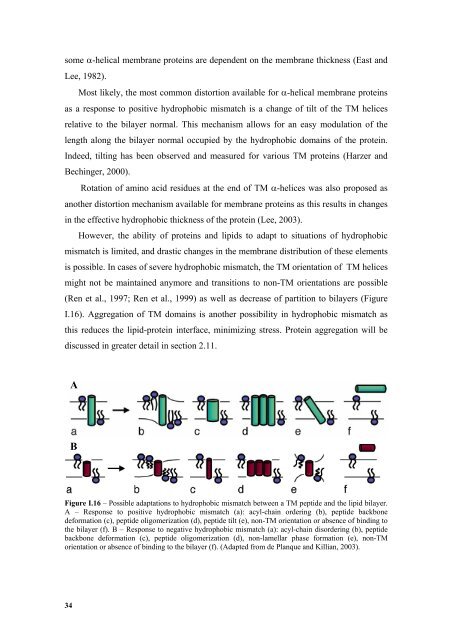Biophysical studies of membrane proteins/peptides. Interaction with ...
Biophysical studies of membrane proteins/peptides. Interaction with ...
Biophysical studies of membrane proteins/peptides. Interaction with ...
You also want an ePaper? Increase the reach of your titles
YUMPU automatically turns print PDFs into web optimized ePapers that Google loves.
some α-helical <strong>membrane</strong> <strong>proteins</strong> are dependent on the <strong>membrane</strong> thickness (East and<br />
Lee, 1982).<br />
Most likely, the most common distortion available for α-helical <strong>membrane</strong> <strong>proteins</strong><br />
as a response to positive hydrophobic mismatch is a change <strong>of</strong> tilt <strong>of</strong> the TM helices<br />
relative to the bilayer normal. This mechanism allows for an easy modulation <strong>of</strong> the<br />
length along the bilayer normal occupied by the hydrophobic domains <strong>of</strong> the protein.<br />
Indeed, tilting has been observed and measured for various TM <strong>proteins</strong> (Harzer and<br />
Bechinger, 2000).<br />
Rotation <strong>of</strong> amino acid residues at the end <strong>of</strong> TM α-helices was also proposed as<br />
another distortion mechanism available for <strong>membrane</strong> <strong>proteins</strong> as this results in changes<br />
in the effective hydrophobic thickness <strong>of</strong> the protein (Lee, 2003).<br />
However, the ability <strong>of</strong> <strong>proteins</strong> and lipids to adapt to situations <strong>of</strong> hydrophobic<br />
mismatch is limited, and drastic changes in the <strong>membrane</strong> distribution <strong>of</strong> these elements<br />
is possible. In cases <strong>of</strong> severe hydrophobic mismatch, the TM orientation <strong>of</strong> TM helices<br />
might not be maintained anymore and transitions to non-TM orientations are possible<br />
(Ren et al., 1997; Ren et al., 1999) as well as decrease <strong>of</strong> partition to bilayers (Figure<br />
I.16). Aggregation <strong>of</strong> TM domains is another possibility in hydrophobic mismatch as<br />
this reduces the lipid-protein interface, minimizing stress. Protein aggregation will be<br />
discussed in greater detail in section 2.11.<br />
A<br />
B<br />
Figure I.16 – Possible adaptations to hydrophobic mismatch between a TM peptide and the lipid bilayer.<br />
A – Response to positive hydrophobic mismatch (a): acyl-chain ordering (b), peptide backbone<br />
deformation (c), peptide oligomerization (d), peptide tilt (e), non-TM orientation or absence <strong>of</strong> binding to<br />
the bilayer (f). B – Response to negative hydrophobic mismatch (a): acyl-chain disordering (b), peptide<br />
backbone deformation (c), peptide oligomerization (d), non-lamellar phase formation (e), non-TM<br />
orientation or absence <strong>of</strong> binding to the bilayer (f). (Adapted from de Planque and Killian, 2003).<br />
34















